This post may contain affiliate links. Please read our disclosure policy.
Xanthan gum has been critical to my ability to develop gluten free recipes since 2005— but I've been searching for a proper xanthan gum substitute for a long time. If you're looking for a way to replace xanthan gum in your baking, I can help!
Here are 4 worthy substitutes. I've tested the first 3 in my recipe for gluten free chocolate chip cookies. The 4th is only for yeast bread:
- Cellulose, or “Perfect Gluten Replacement” (replaced xanthan gum nearly 1:1)
- Guar Gum (about 2.5 times as much as xanthan gum)
- Konjac Powder (a bit more than xanthan gum by volume)
- Psyllium husk (in yeast breads, with varying results)
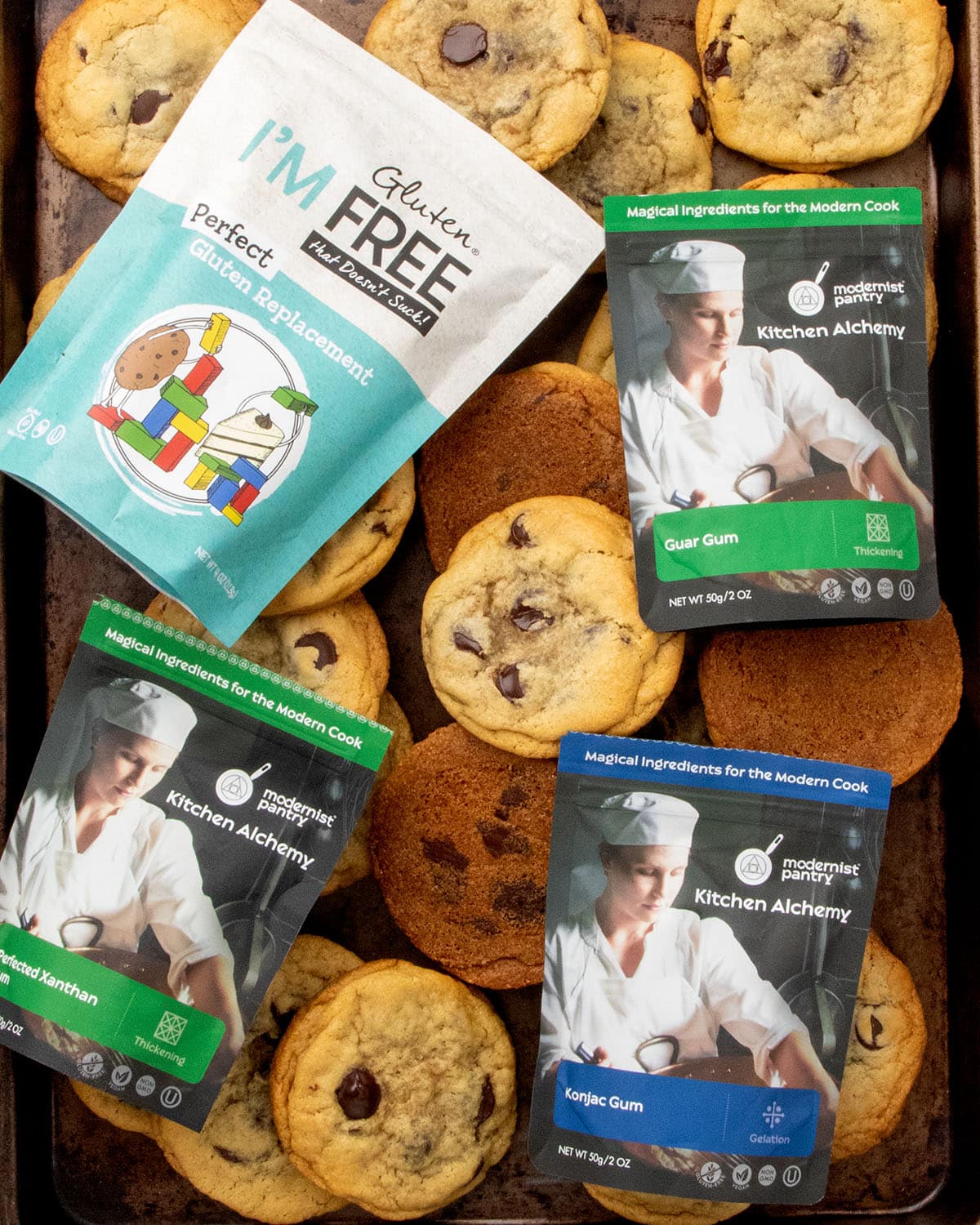
Xanthan gum substitute highlights
The general recommendation for xanthan gum is to use between 0.05% and 0.35% of the total weight of the recipe.
Here's a high-level summary of my findings, but please keep reading for all the details:
- Perfect gluten replacement (cellulose): Retains moisture very well. Performed as well as, if not better than, xanthan gum in the cookies recipe, in larger amounts. Recommended use is 0.75% to 1% total weight of recipe.
- Guar gum: In larger amounts than xanthan gum (about 2.5 x), it worked really well in cookies. Ideal replacement for relatively short baking times at moderate temperatures because it doesn't retain moisture that well. Recommended use is 0.5% to 2% total weight of recipe.
- Konjac powder: Retains moisture well. Required a slightly higher volume, and about 2x by weight, and worked somewhat less well than xanthan gum. Recommended use is 0.5% to 0.7% total weight of recipe.
- Psyllium husk: Not for cakes and cookies, but works remarkably well in yeast bread baking, particularly when there's another binding agent to hold the rise upright. Recommended use is about 2% total weight of recipe.
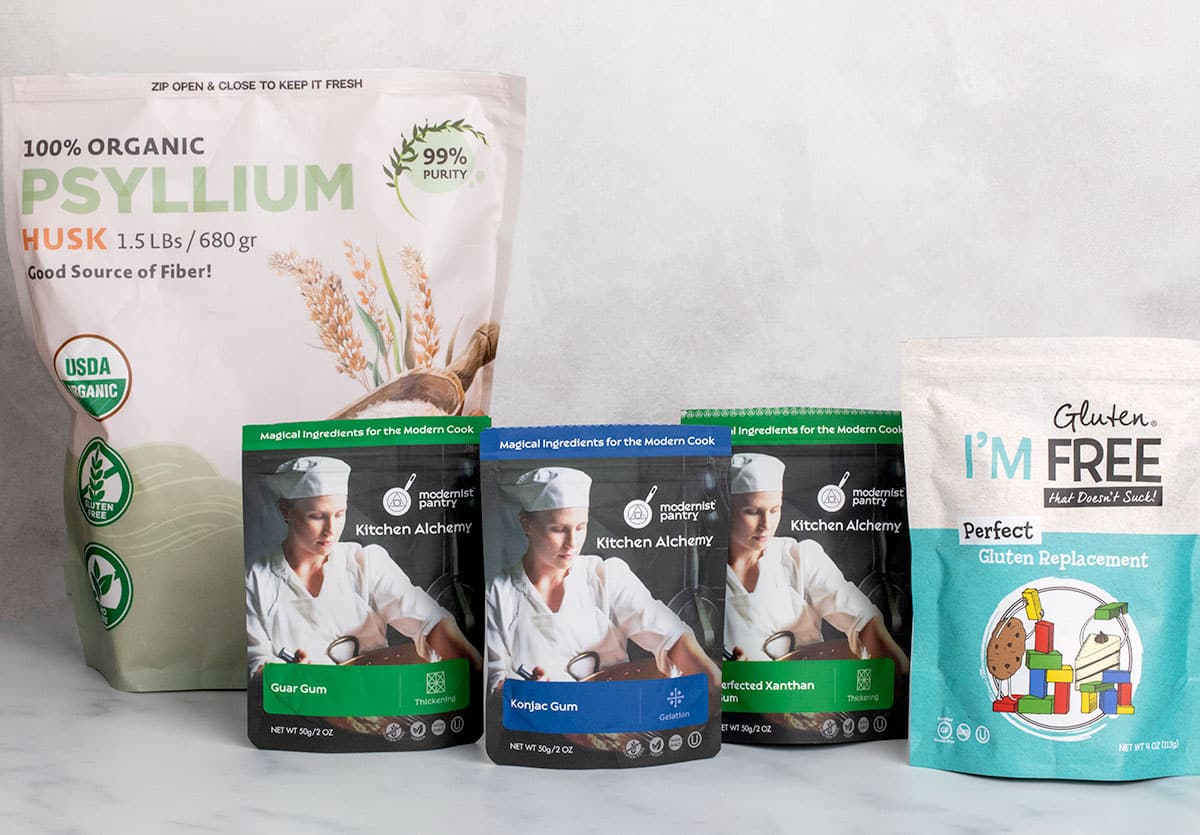
What is xanthan gum & why do we use it?
Xanthan gum is a complex sugar that is created through the fermentation of sugar by naturally-occurring bacteria, which is then dried and ground into a powder. It's a hydrocolloid (that is, creates a gel with water) that has been FDA-approved for use in foods in the U.S. since 1969.
Xanthan gum acts to bind food ingredients together, retain moisture, and add elasticity. It's activated at any temperature and remains stable in very high heat and over long periods of time, making it ideal for replacing some of the properties of gluten in gluten free baking.
Why should you replace it?
In recipes that call for xanthan gum, you should only replace xanthan gum if you don't like it or just don't want to use it. Maybe you're sensitive to it even in the relatively very small amounts it appears in food (usually less than 0.4% of the total weight of the ingredients in a recipe). Or maybe you've just heard that psyllium husk is much better in yeasted gluten free bread than xanthan gum.
In recipes that already call for a gluten free flour blend without xanthan gum, like gluten free pancakes, gluten free crepes, and as the base for a roux for gluten free turkey gravy, you don't need to replace xanthan gum. But in gluten free baking that calls for xanthan gum as a gluten replacement, if you want to avoid it, I'm here to help.
How can you replace it?
To replace xanthan gum in cookies, cakes, muffins, and pastries, I recommend guar gum, konjac powder and cellulose powder for binding, thickening and elasticity. For yeast breads, I also recommend psyllium husk.
There's no magical formula where I can tell you exactly how much of each of these binders to use in place of xanthan gum in absolutely any recipe. Like the ideal amount of xanthan gum to use in any particular recipe varies, so does the amount of each of these substitutes. As a point of reference, xanthan gum weighs about 3 grams per teaspoon.
Guar gum
Guar isn't as good at retaining moisture, so it's not ideal for yeast breads, which are baked at higher temperatures for longer periods of time. I used about 2.5 times as much guar gum in the cookies as I would have xanthan gum. Guar gum weights about 2.6 grams per teaspoon.
Konjac powder
Derived from the tuber of the konjac plant, it's high in glucomannan, a dietary fiber that is known for gelling and thickening properties. I used about 1.5 times more konjac by weight, and about the same amount by volume, as xanthan gum. Konjac weights about 3.2 grams per teaspoon.
Cellulose
Sold by Modernist Pantry as “Perfect Gluten Replacement,” this “modified cellulose” product is a dietary fiber derived from the cell walls of plants. I used quite a bit more cellulose by volume and nearly 2.5 times the weight of xanthan gum. Cellulose weighs about 1.4 grams per teaspoon.
Psyllium husk
A dietary fiber derived from the plantago ovata plant, psyllium husk is sold as the “whole husk” or ground into powder. It turns into a gel in water that resembles hydrated flax, and adds binding, elasticity and makes raw gluten free baked goods easier to handle. It starts to break down at relatively low baking temperatures. Whole psyllium husk weighs about 5 grams per tablespoon.
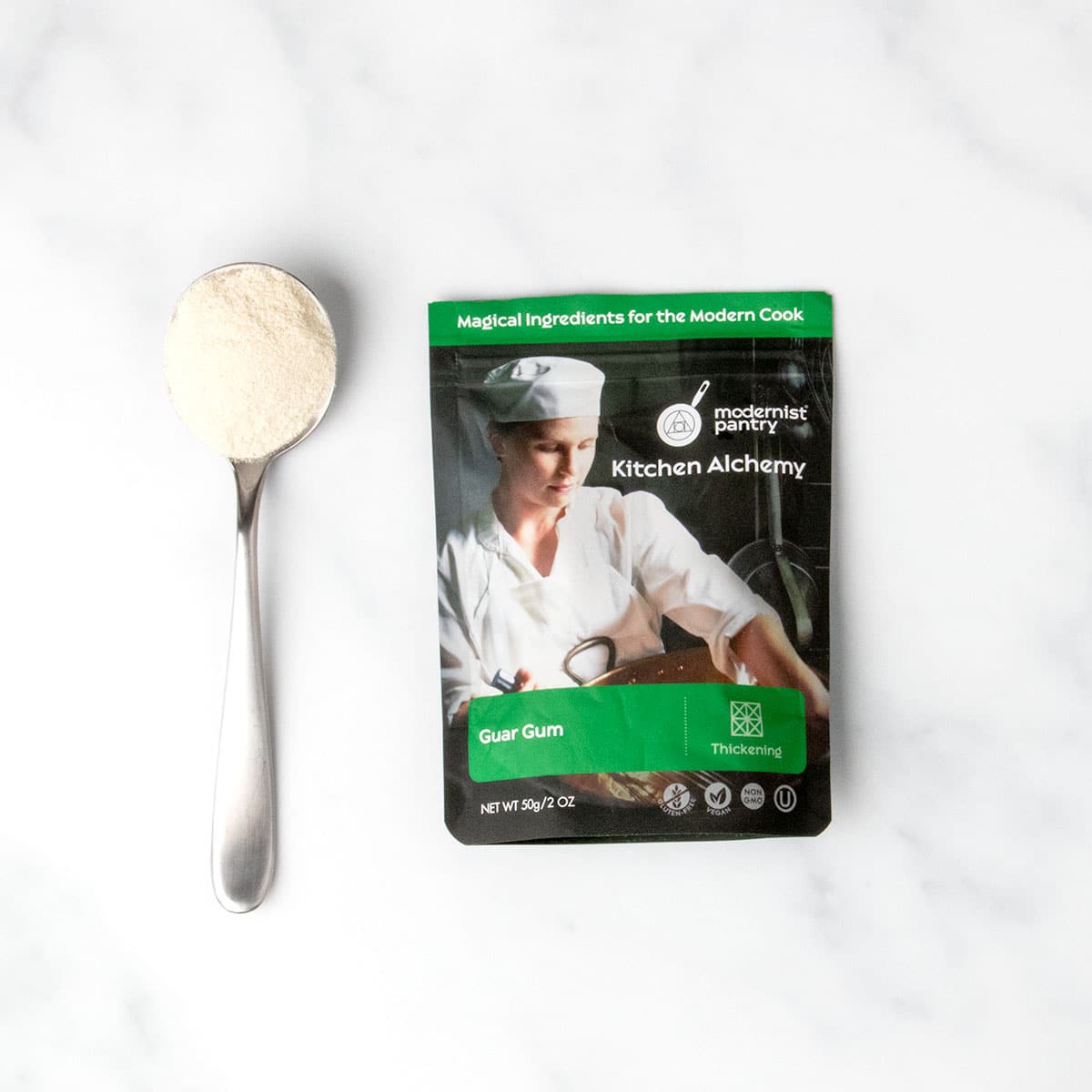
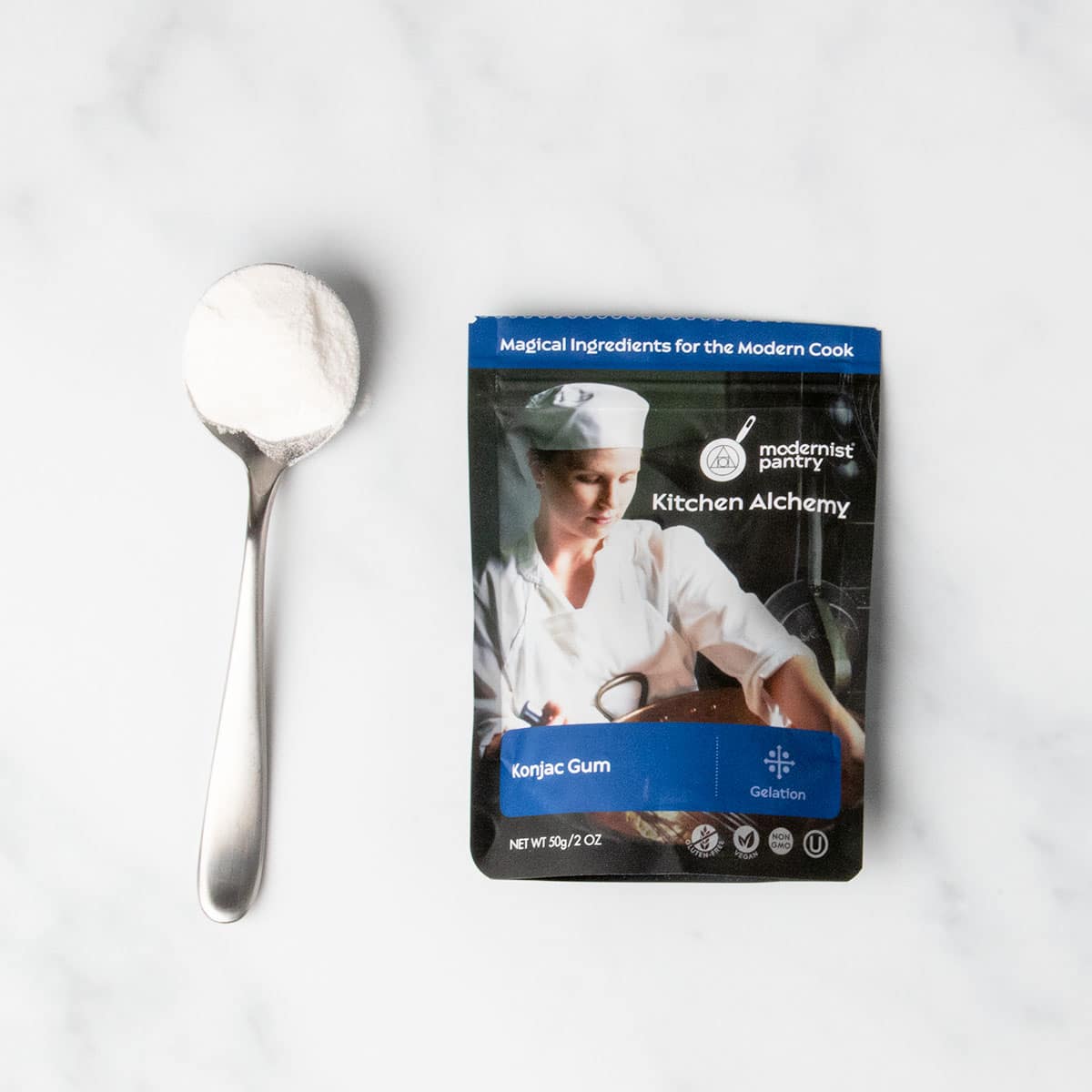
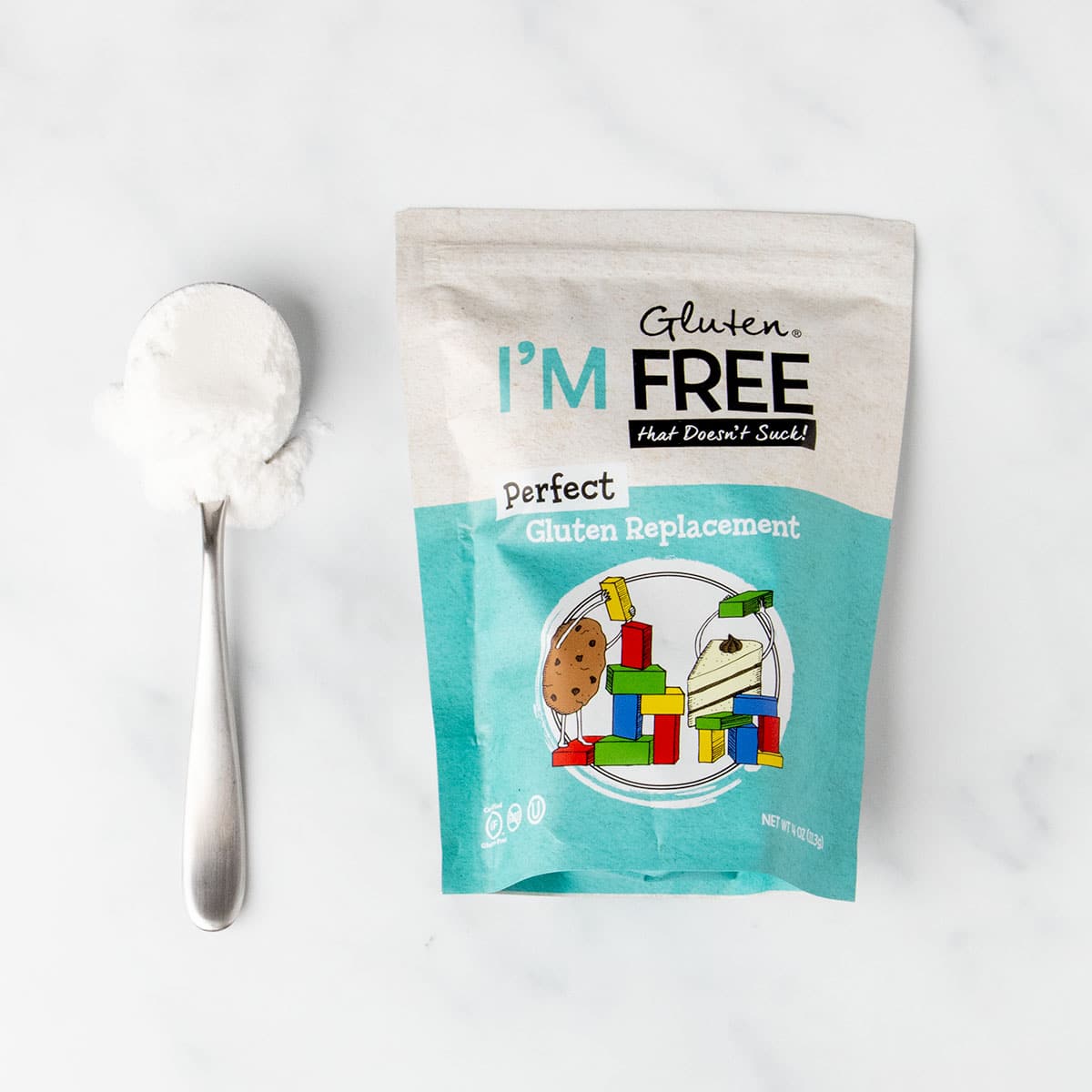
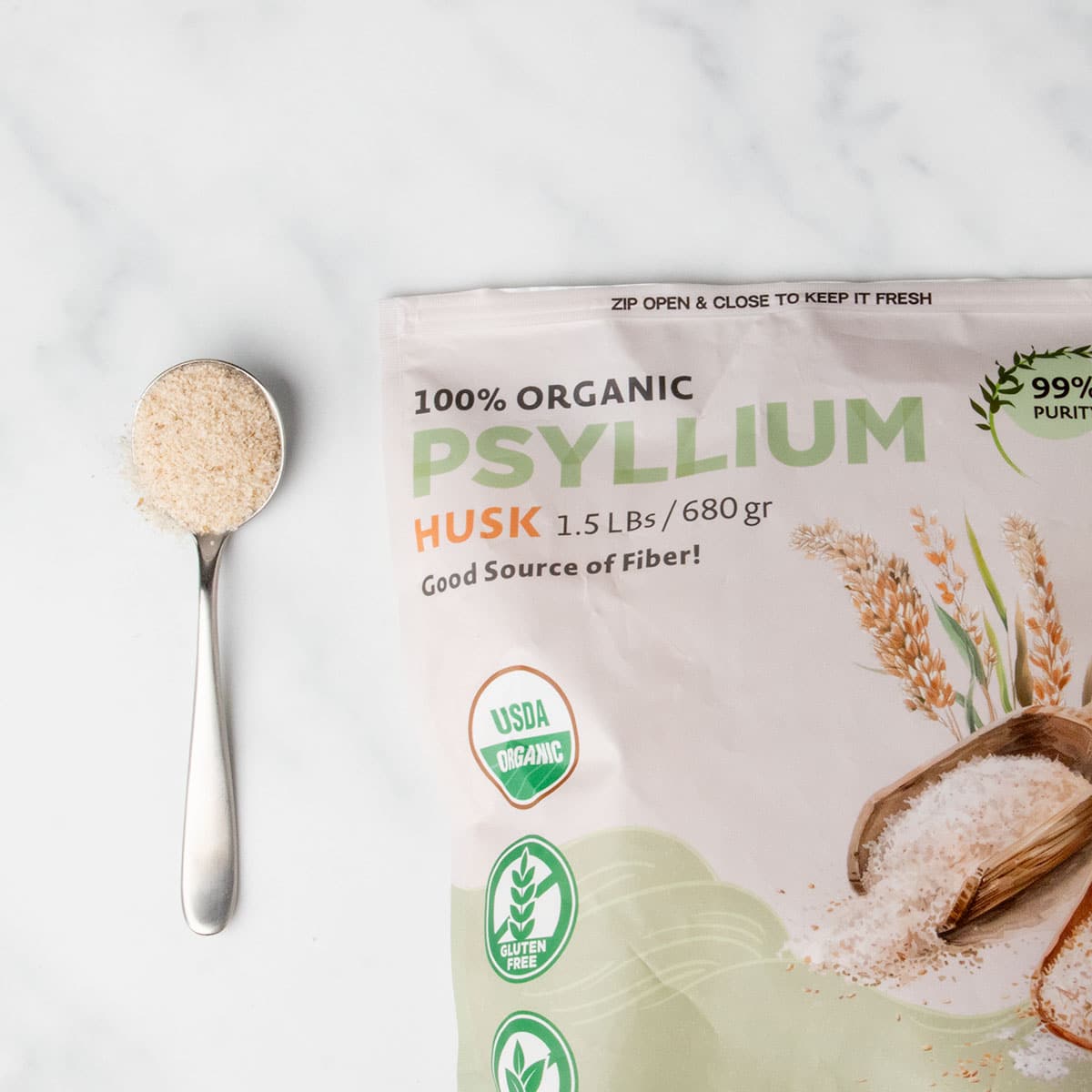
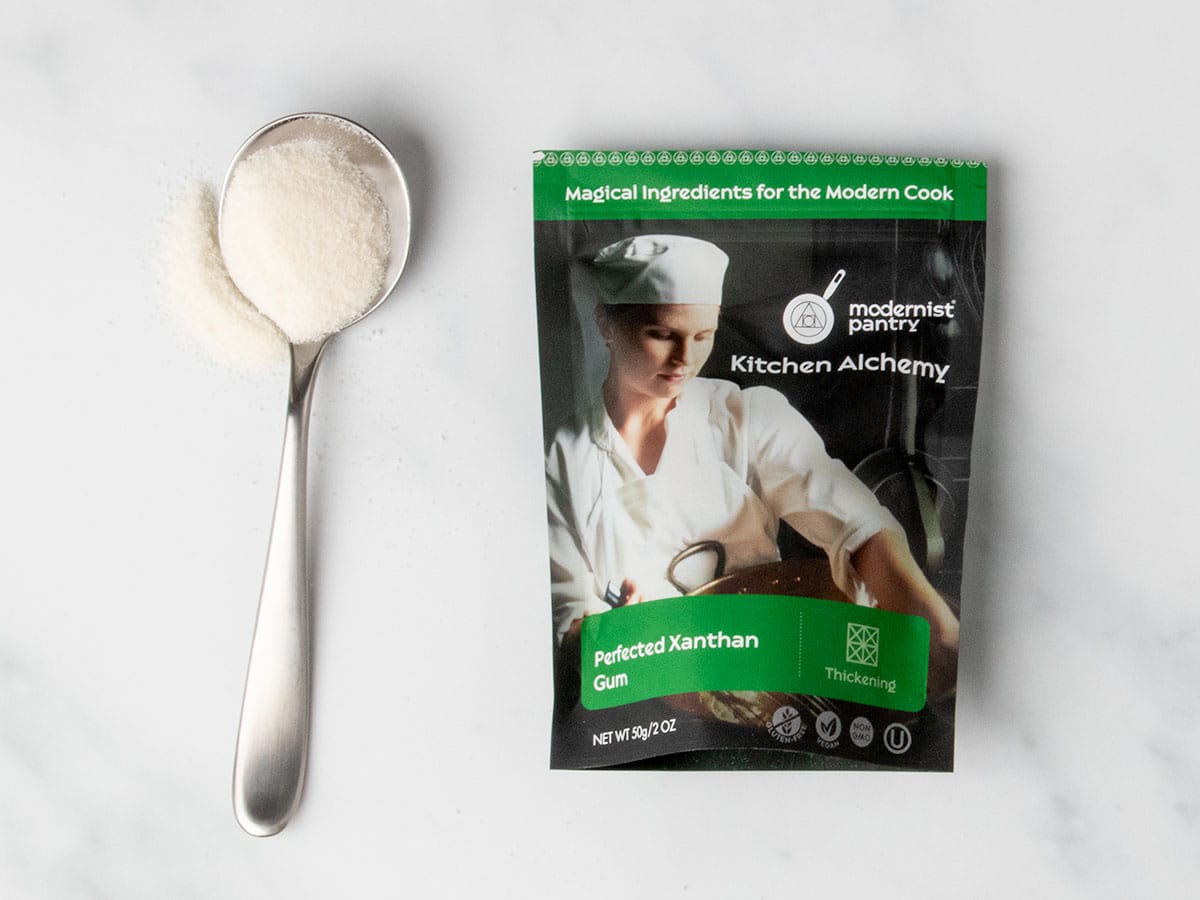
Baking cookies with a xanthan gum substitute
I tested cellulose, guar gum, and konjac powder in my perfect, thick and chewy gluten free chocolate chip cookies recipe. I eliminated psyllium husk from this round of testing because I only like it as a binder in yeast bread.
The testing process
I researched how much of each binder to use in drop cookies like these, and kept every single other ingredient constant as directed in the recipe. I used eggs and butter from the same batches, at the same temperature, in exactly the same amounts. I was meticulous in avoiding cross-contamination of the binders. No cheating!
For the flour blend, I used Vitacost Multi-Blend Gluten Free Flour, which is gum-free, super inexpensive and excellent for drop cookies. I couldn't use Better Batter's classic blend or Bob's Red Mill 1-to-1, which already contain xanthan gum. I didn't want to use Nicole's Best, since it tends to bind somewhat well even without xanthan gum.
I made a half-batch of the cookies, weighed out 50 grams raw dough for each cookie, and let the dough chill for 12 hours exactly before baking according to the recipe instructions.
I used the following exact amount in each 1/2 batch of cookie dough:
- 2 teaspoons guar gum (about 5 grams) (or 1.2 % of total recipe weight)
- 1 teaspoon konjac powder (about 3 grams) (or 0.7 % of total recipe weight)
- 2 1/2 teaspoons cellulose (about 3.7 grams) (or 0.85 % of total recipe weight)
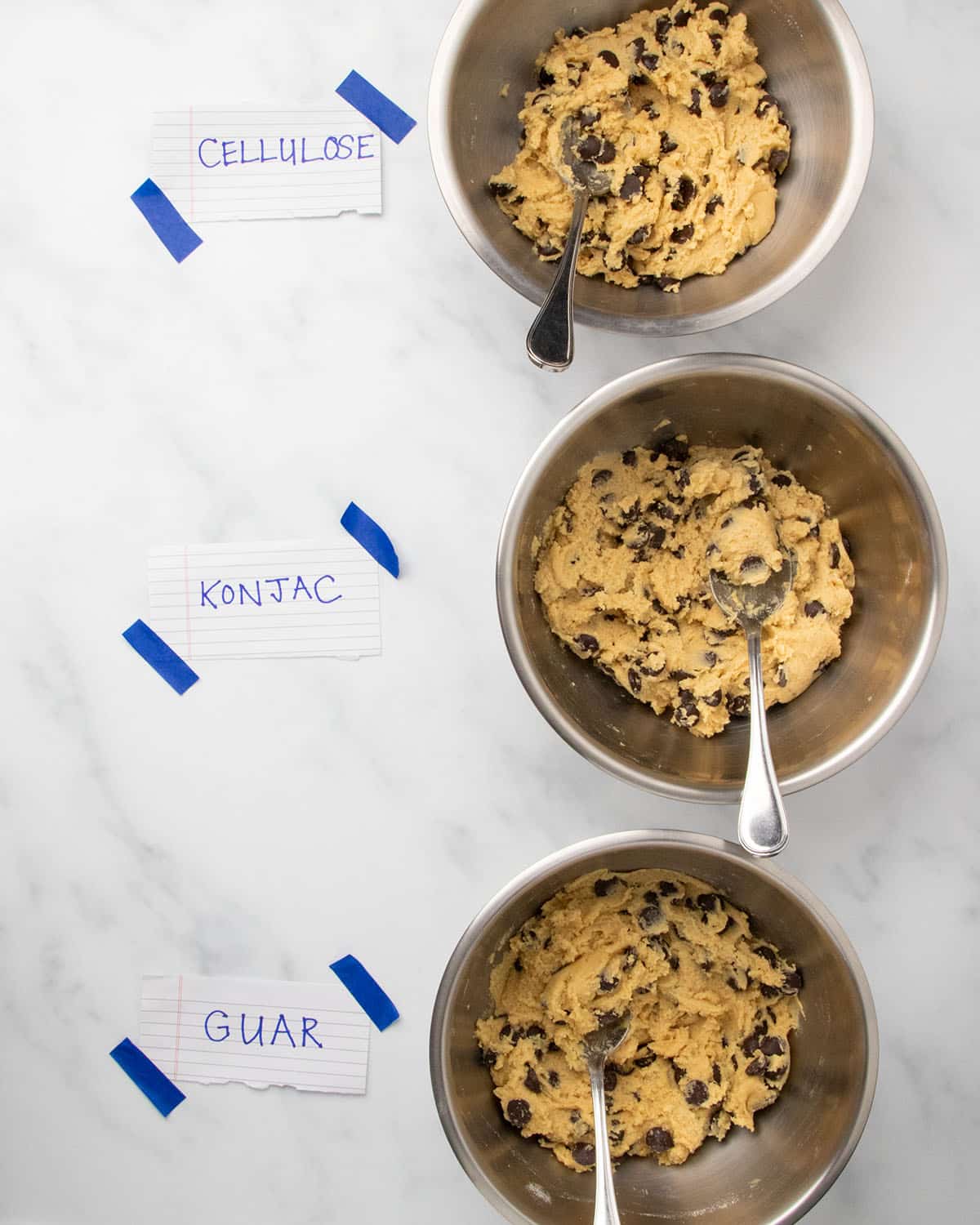
Test results
In making classic drop-style gluten free chocolate chip cookies, here's how guar gum, konjac powder, and cellulose powder performed when I used them in place of xanthan gum in the amounts listed above:
Guar gum
The cookies held their shape beautifully, and the results were nearly identical to what I expect from xanthan gum. No notes!
Konjac powder
The cookies didn't hold their shape quite as well, but I think it might require more for an ideal result. I really liked this in gluten free biscuits without xanthan gum, so I remain really hopeful about it.
Cellulose
This was my favorite binder of the bunch, outperforming even guar gum. The cookies held their shape even as they cooled just like ones made with xanthan gum, without feathering on the edges.

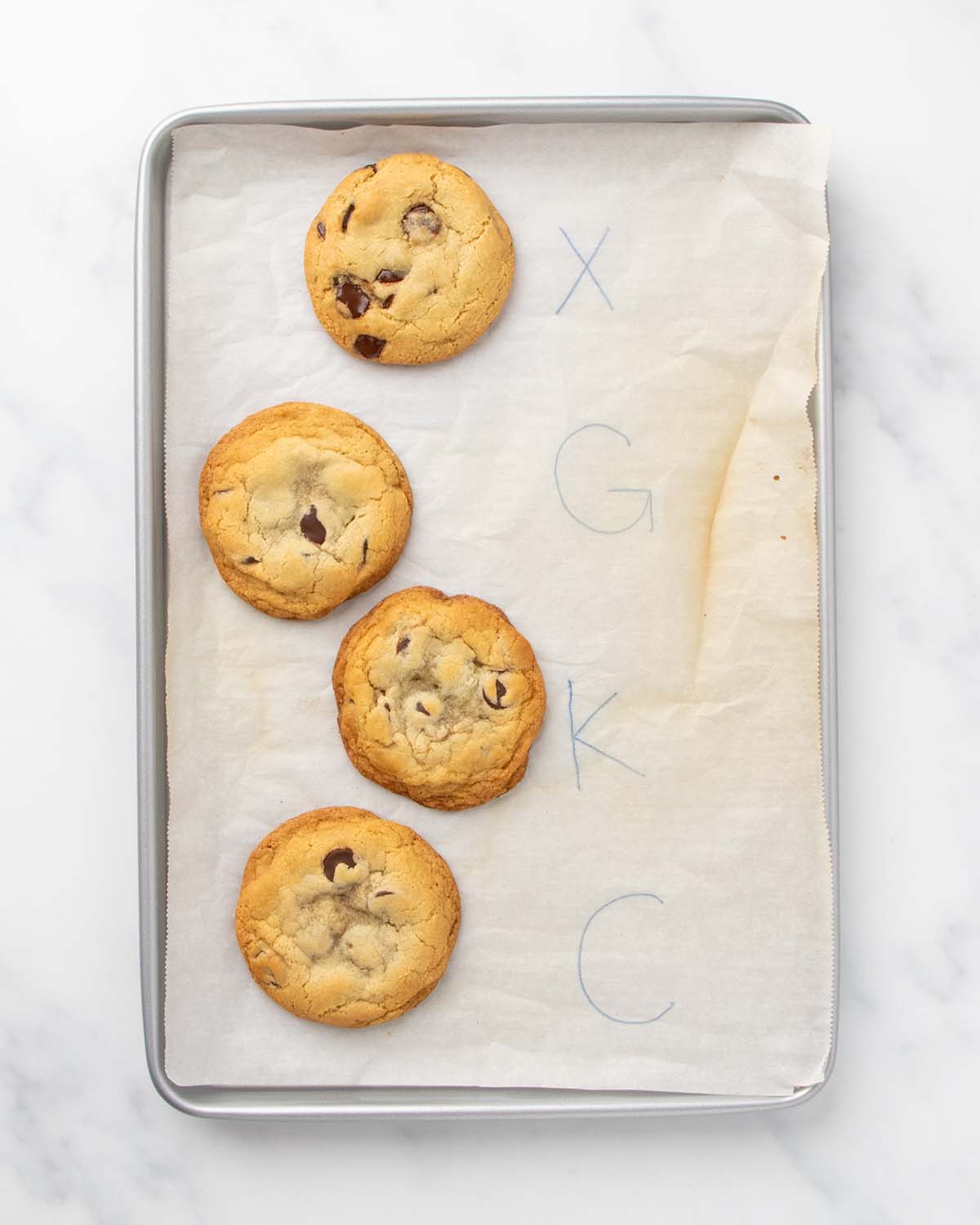
Here's a photo of all of the cookies from all 4 batches, finally able to mingle together. Can you spot which is which? I definitely can't any more!
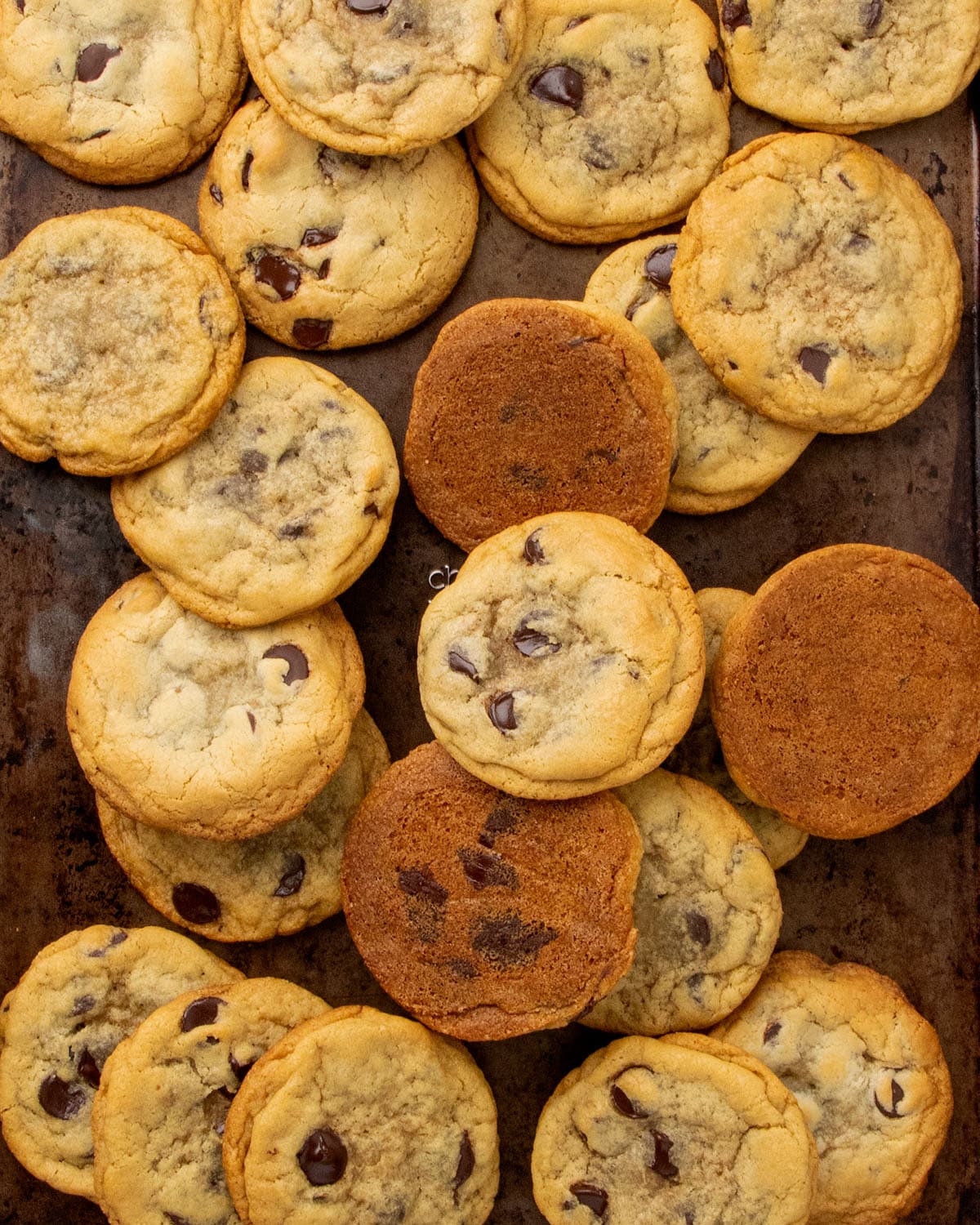
Psyllium husk in gluten free baking
Xanthan gum doesn't break down even at high oven temperatures over long periods of time, so it works beautifully for the long baking times that are often necessary to bake good gluten free bread. But it produces a somewhat boring crumb, and I know that yeast bread with psyllium is easier to handle and even knead (making a stand mixer less important), so I started testing months ago.
General use principles
Be sure to use higher purity “blond” husk, which is a light tan color from which the outermost layer of the husk is removed, or your baked goods may turn a harmless but unsightly blue/purple color. I like NaturaleBio brand whole husk from Amazon, but if it's out of stock, I would buy Yupik brand.
I prefer to use the whole husk, as opposed to psyllium husk powder. If you prefer to use the powder, use about 15% less by weight in a recipe that calls for the whole husk.
Baking a loaf of bread with psyllium
When I used psyllium husk in place of any xanthan gum in my gluten free artisan bread, made in a Dutch oven, I was completely unsuccessful. Without the supportive structure of a loaf pan, the high sides of a Pyrex bowl, or any xanthan gum or substitute, it didn't hold its shape as it cooled.
When I added psyllium in place of xanthan in my classic white gluten free bread recipe, using the Vitacost Multi-Blend Gluten Free Flour, the dough rise quite high but also slumped a bit as it cooled. It was also very damp inside even after cooling for 2 hours. Psyllium gel starts to break down around 180°F, so it requires the right kind of additional support in the form of enough starches, egg whites, and/or ideally some xanthan gum to support the rise as it cools.
Next, I added 20 grams of psyllium husk and 1 extra tablespoon of lukewarm water to my gluten free bread recipe, using Better Batter's classic blend which already contains xanthan gum. It was one of the best gluten free loaf breads of my life, with a crisp crust, a tender inside that was moist but not wet, and a lot of bready taste and aroma. It also had a longer shelf-life.
You can see below how it rose really high and has a pleasantly irregular crumb thanks to the psyllium husk, and held its shape beautifully after rising very high thanks to the egg whites—and the xanthan gum. Xanthan gum alone tends to yield a very regular, uniform crumb, but this was a more gluten-like crumb.
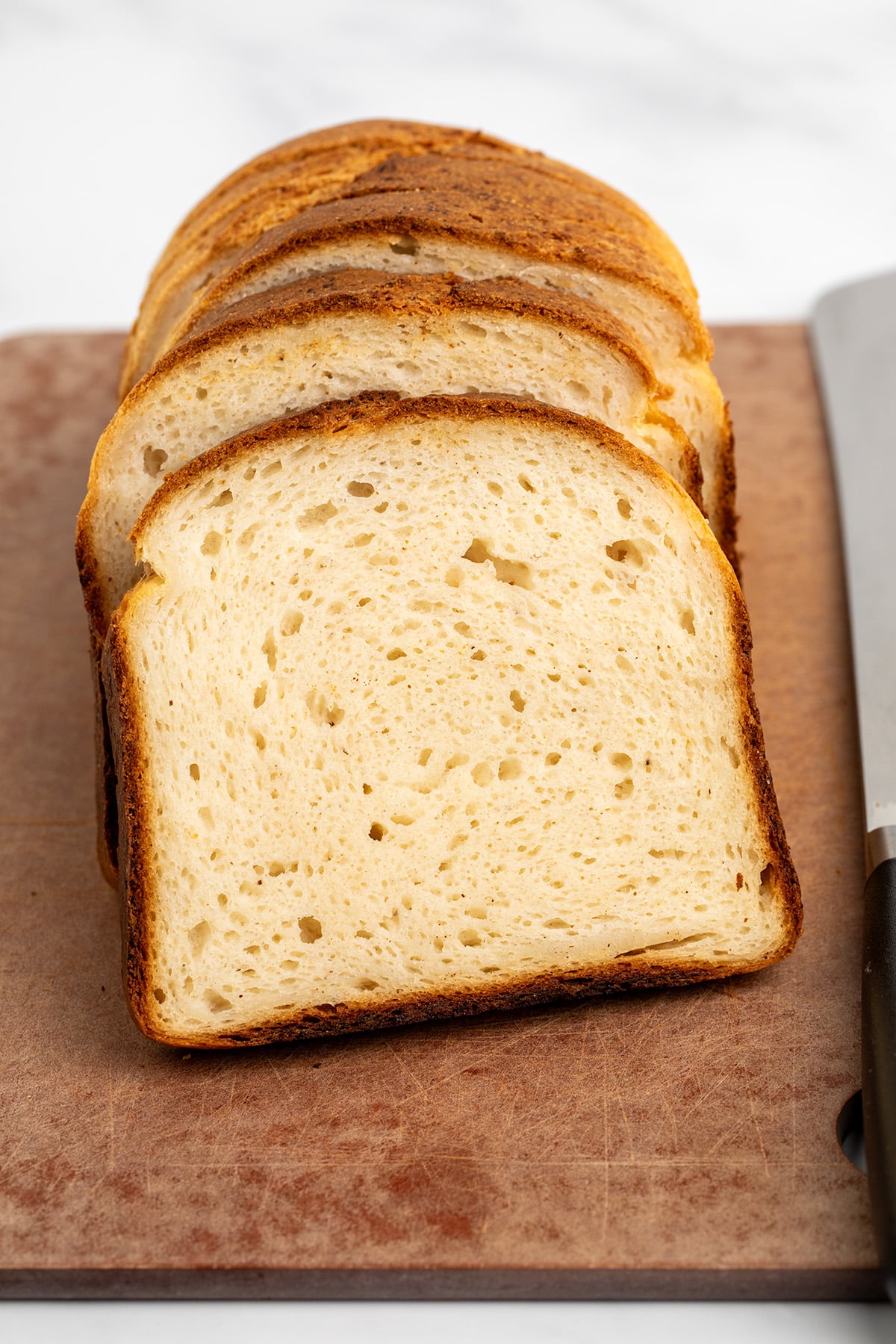
Baking shaped bread with psyllium
So far, I have not liked using psyllium husk in place of xanthan gum entirely in shaped gluten free bread made with an all purpose gluten free flour blend. I've tried gluten free bagels and gluten free cinnamon rolls, but they didn't hold their shape.
I do really love the combination of xanthan gum and psyllium husk in shaped gluten free breads, though, made in my usual style.
In my recipe for gluten free cinnamon rolls, I used the Vitacost gum-free blend, but added xanthan gum and psyllium husk with great success. The rise was even and controlled, with tons of oven spring, and the rolls were chewy and even held the filling better.
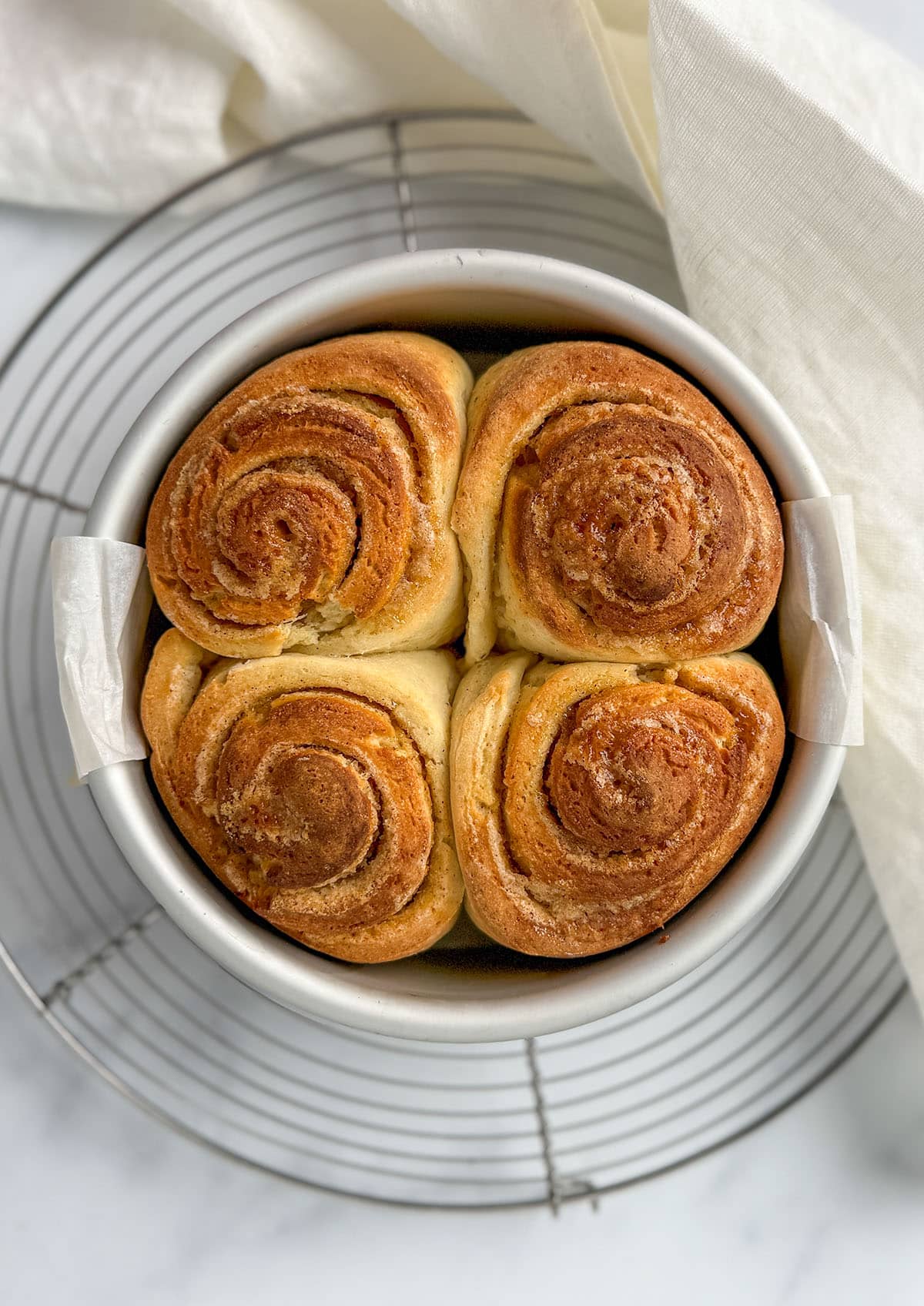
Psyllium husk + a xanthan gum substitute in breads
Next, I plan to test these yeasted gluten free bread recipes using either konjac powder or cellulose in place of xanthan gum plus psyllium husk. I expect really good results. I won't try guar gum, since I expect it won't retain moisture over the long baking time.
FAQs
If a recipe calls for xanthan gum but you're using a gluten free flour blend that already contains it, leave it out. Otherwise, you need to replace it with an alternative in the right amount for that type of recipe, or your baked goods will be crumbly, dry, and will go stale more quickly.
No, although cornstarch does thicken liquids to create a roux and can be used to thicken pudding, it does not create elasticity or gel like xanthan gum in any amount as a gluten-replacer.
Pectin can be useful in gluten free baking, but I haven't been successful in using it to replace xanthan gum.
I haven't been successful in using gelatin to replace xanthan gum.
I like konjac, guar gum, or cellulose as a replacement for xanthan gum in pastries, cookies, cakes, muffins, and quick breads. You'll need varying amounts of each, but I think they're all effective substitutes.
No, baking powder contains a chemical leavener (baking soda), a starch, and an acid (usually cream of tartar). It doesn't bind, thicken, or retain moisture like xanthan gum.
No, although they do have some gelling properties, they won't provide the gluten-like network that xanthan gum, konjac powder, cellulose, guar gum, or psyllium husk can.




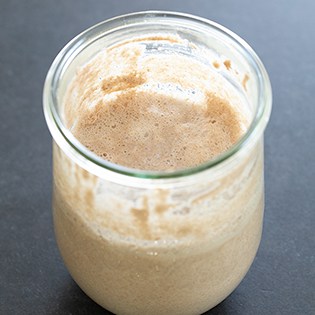









Interesting article Nicole, thank you.
I don’t like using xanthan gum, as it can be derived from corn, and my daughter is highly allergic to corn.
I have had bread making success with using a combination of guar gum and psyllium husk (whole). It took some trial and error to figure out how much of the husk to use, but I got it sorted and my bread is pretty good. Even my baker daughter thinks so!
You are an amazing person to share your knowledge like this. You need to know I appreciate you, and your recipes, very much.
Be well!
Thank you so much, Mary-Ann, for the kind words. Yes, a corn allergy is one of the most common reasons I’ve heard over the years for avoiding xanthan gum. I too like a combination of psyllium husk and xanthan gum or an alternative for bread baking. You might like the Perfect Gluten Replacement better than guar gum, since it can survive longer bakes. I think it’s better for bread than guar. Thank you for sharing your thoughts!
Thank you for explaining what to and what not to do. I have a lot to learn, especially trying to make bread and bake.
You’re so welcome, John! There’s a learning curve, but now that I’ve gathered this information, I can start adding amounts of xanthan gum alternatives to use in different recipes, so you don’t have to guess. :)
Your thoughts and step by step process are very helpful. Great information. Thank you.
You’re so welcome, Barbara. Thank you for sharing your thoughts!
I appreciate this post. We’ve had to stay clear of xanthan gum due to a corn allergy. It’s been challenging navigating that. I finally started making my own bread using psyllium husks, and it’s been a total game changer. Perfect bread and amazing cinnamon rolls. I feel like I am using more tapioca starch than I’d like so I’ve been reworking recipes trying to bring in more whole grains instead.
I think you’d like your bread even more if you used one of the other xanthan gum substitutes (like konjac powder) alongside psyllium husk, since psyllium gel breaks down at such a low oven temperature. Thanks for sharing your thoughts!